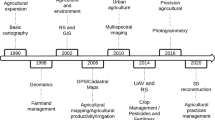Abstract
In remote sensing, thematic map comparison is often undertaken on a per-pixel basis and based upon measures of classification agreement. Here, the degree of agreement between two thematic maps, and so the difference between the pair, was evaluated through visual and quantitative analyses for two scenarios. Quantitative assessments were based on basic site-specific measures of agreement that are used widely in accuracy assessment (e.g. the overall percentage of pixels with the same class label in each of the two maps and the kappa coefficient of agreement) as well as an information theory based approach that allows the degree of mutual or shared information to be assessed even if different classification schemes have been used to produce the maps. The results indicated that in the first map comparison scenario, focused on labelling, there was a fair degree of correspondence between the maps but with an overall difference in information content of ∼42%. In the second comparison scenario, focused on change in time, considerable change had occurred with a change in class label for ∼42% of the pixels. It was also apparent that global assessments masked local scale changes.

Similar content being viewed by others
References
Cohen J (1960) A coefficient of agreement for nominal scales. Edu Psychol Meas 20:37–46
Comber A, Fisher P, Wadsworth R (2004a) Integrating land-cover data with different ontologies: identifying change from inconsistency. Int J Geogr Inf Sci 18:691–708
Comber A, Fisher P, Wadsworth R (2004b) Assessment of a semantic statistical approach to detecting land cover change using inconsistent data sets. Photogramm Eng Remote Sens 70:931–938
Congalton RG, Green K (1999) Assessing the accuracy of remotely sensed data: principles and practices. Lewis Publishers, Boca Raton
Congalton RG, Oderwald RG, Mead RA (1983) Assessing Landsat classification accuracy using discrete multivariate analysis statistical techniques. Photogramm Eng Remote Sens 49:1671–1678
Couto P (2003) Assessing the accuracy of spatial simulation models. Ecol Model 167:181–198
Csillag F, Boots B (2006) Categorical maps, comparisons, and confidence: results from a virtual workshop. What is the difference between two maps? A remote senser’s view (this issue)
Finn JT (1993) Use of average mutual information index in evaluating classification error and consistency. Int J Geogr Inf Syst 7:349–366
Foody GM (1992) On the compensation for chance agreement in image classification accuracy assessment. Photogramm Eng Remote Sens 58:1459–1460
Foody GM (2004) Thematic map comparison: evaluating the statistical significance of differences in classification accuracy. Photogramm Eng Remote Sens 70:627–633
Fritz S, See L (2006) Comparison of land cover maps using fuzzy agreement. Int J Geogr Inf Sci (in press)
Giri C, Zhu Z, Reed B (2004) A comparative analysis of the Global Land Cover 2000 and MODIS land cover data sets. Remote Sens Environ 94:123–132
Hagen A (2003) Fuzzy set approach to assessing similarity of categorical maps. Int J Geogr Inf Sci 17:235–249
Hayes DJ, Sader SA (2001) Comparison of change-detection techniques for monitoring tropical forest clearing and vegetation regrowth in a time series. Photogramm Eng Remote Sens 67:1067–1075
Kew NR (1996) Information-theoretic measures for assessment and analysis in image classification. In: Binaghi E, Brivio PA, Rampini A (eds) Soft computing in remote sensing data analysis. World Scientific, Singapore, pp 173–180
Li B, Chu Y, Loh DK (1993) Event probability correlation analysis for comparison of two-phase ecological maps. Ecol Model 69:287–302
Monserud RA, Leemans R (1992) Comparing global vegetation maps with the Kappa statistic. Ecol Model 62:275–293
Pontius RG (2002) Statistical methods to partition effects of quantity and location during comparison of categorical maps at multiple resolutions. Photogramm Eng Remote Sens 68:1041–1049
Pontius RG, Malizia NR (2004) Effect of category aggregation on map comparison. Lect Notes Comput Sci 3234:251–268
Power C, Simms A, White R (2001) Hierachical fuzzy pattern matching for the regional comparison of land use maps. Int J Geogr Inf Sci 15:77–100
Stehman SV (1997) Selecting and interpreting measures of thematic classification accuracy. Remote Sens Environ 62:77–89
Townsend PA (2000) A quantitative fuzzy approach to assess mapped vegetation classifications for ecological applications. Remote Sens Environ 72:253–267
Turk G (2002) Map evaluation and “chance correction”. Photogramm Eng Remote Sens 68:123
Woodcock CE, Gopal S (2000) Fuzzy set theory and thematic maps: accuracy assessment and area estimation. Int J Geogr Inf Sci 14:153–172
Wulder MA, Boots B, Seemann D, White JC (2004) Map comparison using spatial autocorrelation: an example using AVHRR derived land cover of Canada. Can J Remote Sens 30:573–592
Acknowledgements
I am grateful to Ferko Csillag and Barry Boots for organising the project and the referees for their constructive comments.
Author information
Authors and Affiliations
Corresponding author
Rights and permissions
About this article
Cite this article
Foody, G.M. What is the difference between two maps? A remote senser’s view. J Geograph Syst 8, 119–130 (2006). https://doi.org/10.1007/s10109-006-0023-z
Published:
Issue Date:
DOI: https://doi.org/10.1007/s10109-006-0023-z




